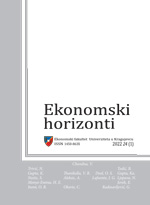MEAN-EXPECTED SHORTFALL PORTFOLIO OPTIMIZATION USING A GENETIC ALGORITHM
Vladislav Radak1, Aleksandar Damjanović1, Vladimir Ranković2 and Mikica Drenovak2
1University Union, School of Computing, the Republic of Serbia
2University of Kragujevac, Faculty of Economics, the Republic of Serbia
Capital requirements for the market risk exposure of banks is a nonlinear function of the expected shortfall (ES), which is calculated based on a bank’s actual portfolio, i.e. the portfolio represented by the bank’s current holdings. To tackle portfolio optimization with respect to the ES, a genetic algorithm (GA) is used in this paper. The paper examines the effectiveness of a specific GA technique, namely the Strength Pareto Evolutionary Algorithm 2 (SPEA2) for portfolio optimization when the expected return (the mean) and percentage ES are set as the optimization goals. In addition, the differences between the mean-ES optimal portfolios and the mean-VaR optimal portfolios obtained by using the same optimization algorithm is analyzed in the study. The results document that the SPEA2 method provides well-distributed portfolios along the efficient frontier covering different risk levels. Compared to the mean-VaR optimal portfolios, the mean-ES optimal portfolios document superiority over the entire efficient frontier in the mean-ES plane. Concurrently, the converted mean-ES portfolios seem to converge towards the mean-VaR portfolios in the mean-VaR plane and nearly coincide for the high levels of the expected return.
Keywords: portfolio optimizacija, očekivani gubitak, VaR, SPEA2
JEL Classification: C61, C63, G11, G17, G21




